
Explore the exotic flavors of Tahitian cuisine
The traditional Tahitian cuisine has evolved, like most cuisines in the world, over hundreds of years, with the seasons, taking into account local food supplies availability, plants edibility, and of course the bounty of the sea.
From fish-based specialties to corned beef, from rice with tubers that accompany traditional and signature dishes like raw fish with coconut milk, from firi firi (fritters) to chao pao (steamed breads), each recipe, each dish, and each product tells a little part of the Polynesian soul and history. Get ready for a journey of flavors!
The secrets of traditional Tahitian cuisine
Tahitian cuisine, like that of the other archipelagos, was initially subsistence farming: eating was a physiological necessity. The ancient Polynesians learned to use resources: boiling tubers, which contain calcium oxalate crystals that make them bitter, irritating, even dangerous if eaten raw. They also adapted to the seasons, with a scarcity of food at certain times of the year (especially the dry season), but also to the migration of some marine species.
A unique preservation of food
Tahitian cuisine was original due to its staple foods. The ancient Polynesians were eating breadfruit tree (‘uru), rather than taro or ƒ‘umara (sweet potato) preferred in the Western Pacific. Its originality also came from the food storage; no drying or salting as in Aotearoa, due to high humidity; no smoking system as in Hawaii, but “standing” conservation. In other words, products were constantly fresh through permanent crop rotations, but also constant farming and fish farms. Finally, fermentations in the 'uru' oven (preparation called mahi) made it possible to deal with hard times or to wait between two cycles.
Cooking stew-style : the traditional oven
You will probably have the chance to attend the preparation of a buried oven, the famous ahimā'a, or its opening. This cooking method gave birth to a much-awaited weekly meeting: the mā'a Tahiti.
Mā'a Tahiti is ‘the buried oven’ cooking method, where volcanic stones are heated. Once the right temperature is reached, the food (vegetables, tubers, bluefin tuna, swordfish or mahi mahi, shellfish, chicken or pork) is wrapped in leaves of different natures and flavors (bananas, noni), placed on the stones, and covered with other hot stones and sand. They are finally smothered for several hours. The opening of an ahimā'a is a feast. All the dishes are then laid out on large tables and shared between people during meals called tāmā'ara'a.
Many hotels and some restaurants in the archipelagos offer this activity at the end of the week. In the Marquesas it is called umu kaikai. Its name is umu 'ai in the Australs (the apostrophe before a vowel is pronounced like a "k").
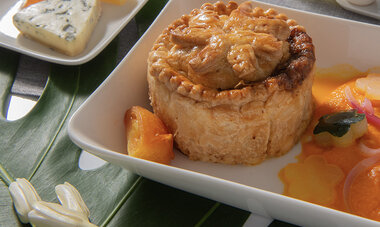
Flavors from all over the world
English influences
The British were the first Europeans to settle in the Polynesian islands. Their primary culinary influence is the famous “pie” - both a fruit tart and a meat pie - which the missionaries loved and which were adopted by the Tahitians. Some also say that the po'e has an English origin, especially with the mei'a (bananas), based on the famous pudding.
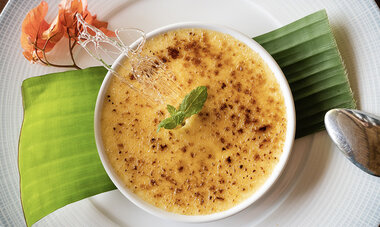
French influences
From 1842 and the Protectorate imposed by France on Queen Pomare IV, the French settled more and more in Tahiti than in the other islands. The influence of French products and gastronomy, based on locally processed foods, has created a more refined cuisine, with local products often valued.
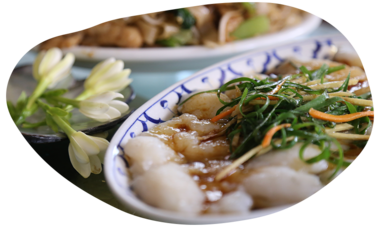
Chinese influences
Polynesian recipes will never cease to amaze you! In 1865, 300 Chinese from southern China arrived in Tahiti to work in the Atimaono sugar cane plantation in Papara. When the plantation went bankrupt, some preferred to stay in Tahiti. Their community had grown rapidly with new members over the years. They have established themselves sustainably. Producing one of the best cuisines in the world, the Chinese culinary culture majorly contributed to the local gastronomy (spices, cooking). It is now complemented by other influences from Southeast Asia such as Viet Nam and Thailand among others. This is why chao men (fried noodles), pork with oyster sauce, sashimi (with its signature sauce, including soy sauce, oyster sauce, and oil), nems, bouchons, phô, taro, and crab fritter are now part of the traditional diet.

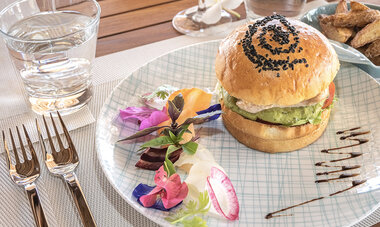
American influences
In 1942, an American base was created in Bora Bora when the general staff feared an invasion of French Polynesia by the Imperial Japanese Army. The GIs were fed by entire boatloads of corned beef (locally called punu pua’atoro) and coke. The inhabitants of the Raromatai (the Polynesian name for the archipelago of the Leeward Islands) took advantage of these commodities and became very fond of them even before this food arrived in Tahiti and Moorea. For several years, burgers and pizza have been the undisputed king and queen of Tahitian tables, from trailers to restaurants.
Tahitian cooking today
Mā’a Tahiti is a must-try during your trip in French Polynesia. You will enjoy a large variety of fish, marinated raw fish with coconut milk. The chicken fāfā (young leaf of the taro, also called “Polynesian spinach”), the pua’a (pork roast) with cabbage, and lagoon fishes cooked in leaves within the sand to maintain heat. The steaming process releases the flavors. You will also have the chance to taste tubers (taro, ‘umara, sweet potato, ufi - yam, cassava…) in various cooking methods and other vegetables (fē’ī – cooked banana, sometimes māpe, the Polynesian chestnut, often sold in small packets at traffic lights). At the end of your meal, the traditional po'e will lull you into a well-deserved nap in the shade of an Autera’a tree (Badamier).
The unmissable dishes and ingredients
Tubercles, fruits (banana, mango, pineapple, etc.), rice, fish, pork and poultry are among the main ingredients in Tahitian recipes.
If you have the opportunity to eat them during your vacation, you should try:
Raw fish in coconut milk (Poisson cru au lait de coco), cooked with a little lemon and often made with albacore tuna and served with rice or fries. The Poisson cru au lait de coco is the signature dish of Tahiti and her islands.
Kaveu, coconut crab, served in some restaurants.
Varo or squill (which cannot be caught from the end of October to February), even finer than lobster. Other shellfish (shrimp, slipper lobster) are also excellent.
'Uru punu pua'atoro, 'uru (breadfruit) baked in the oven with corned beef and onions grilled in a frying pan. It is one of the favorite dishes of the Polynesians.
Vana (local sea urchin tongues), delicately drizzled with Marquesan lemon juice, seafood to be eaten directly on the beach.
Remu vine, a seaweed nicknamed “Caviar of the Austral Islands”, whose texture is reminiscent of lemon caviar and whose taste evokes those South Seas, between sea salt and the scent of sea spray.
As for traditional or iconic dishes, don't miss the ipo or coconut bread, and the firi firi, traditional Sunday morning fritters.
As for fruit, rediscover the classics, tasting banana, pineapple, mango and coconut, which are infinitely more flavorful in this tropical climate. Also try papaya, star fruit and rambutans to discover new flavors. Of course, vanilla is not to be forgotten. Mainly cultivated on the island of Taha'a, Polynesian vanilla is recognized worldwide for its quality and delicate taste.
Finally, try a mā'a tinito (which can be translated as a Chinese dish, consisting of bacon, red beans, Chinese beans, vermicelli and soy sauce, among other ingredients). This recipe was invented in Tahiti in the 1930s. It is the result of a combination of French, Tahitian and Chinese ingredients. It is a delicious reflection of the wonderful blend of customs, skills and ethnic groups in French Polynesia.
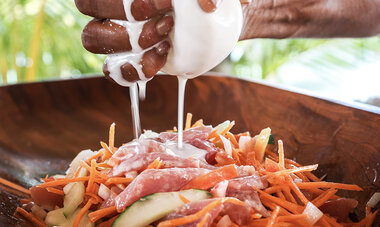
Fafaru, a local culinary experience
People will probably suggest you have a try on a Sunday of mā’a Tahiti - accompanied by a big smile that will inevitably end in a burst of laughter - the fāfaru. A specialty of our islands is fresh fish or shellfish immersed for a precise time (from a few minutes to several hours) in brine made up of seawater and fermented chevrettes (freshwater prawns). The initial smell is not very pleasant, and the taste is uncanny. You either love or hate it, such as Maroilles cheese, spicy chili, or sour Chinese candy... It is an experience that will make you laugh or not…
Travel tips : the best restaurants in Tahiti
With our partner Tama'a magazine, we offer you this selection of restaurants highlighting local products with taste and originality.
Recommended restaurants in Papeete
Hei
Heiarii Hoiore, a native of Raiatea, and his companion Heimataiki Contios run this gourmet beachfront restaurant in Papeete by the Pearl Museum. An inventive market cuisine composed of fresh/ local products and magnified by fine products from abroad. A special tasting menu is offered every day. It is one of the 4 best addresses on the island.
Maru Maru
Originally Chef Teao Maiarii wasn’t intended to be a cook. During his studies in France, he changed course to the delight of your taste buds. His restaurant - hosted in the shade of a beautiful marumaru tree - celebrates the local products he knows better than anyone. His restaurant is undoubtedly one of the 4 best places to eat in Tahiti.
L’Aubergin’
You must climb to the heights of Papeete - at the Pic rouge - to taste the cuisine of Chef Fabrice Metais. This Tahitian chef loves turning the recipes of the most traditional dishes into a disconcerting but always gourmet creation. One of the 4 best addresses on the island.
The other recommended restaurants in Tahiti
Le Lotus – Intercontinental Tahiti
Famous restaurant of the Intercontinental Tahiti Hotel, especially for its two rotundas overlooking the lagoon.
The Lotus has distinguished itself locally by its fine authentic, and local cuisine. Under the leadership of chef Franck David and advised by the two Michelin-star chefs Bruno Oger, this is one of the best restaurants on the island.
Best restaurants in Papara
Snack roulotte O Tumu Māpe
Food trucks like this are uncommon in Tahiti: say goodbye to the junk food far too represented in our local snacks and food trucks. O Tumu Māpe is a food truck that has an exceptional cooking style, using products from the fa'a'apu (vegetable garden), the mountain, and the lagoon, making their guests feel at home. It is an ideal stop during your tour of the island, perfect for a family lunch.
Best restaurants in Taravao (Peninsula)
Le Manoa
Here is a joyful and gourmet address in Taravao. The dishes are hearty, with a strong presence of seafood. Remember to book before coming, especially if you travel during the hot season. Thus you will be able to enjoy the air-conditioned room.
L’escale du France in Vairao (Maui Beach)
Famous stopover of the liner France. It is a beachfront snack-style restaurant located a few kilometers before the mythical wave of Teahupo'o. Here, you can taste giant clam (tridacna), goat curry or shrimp, and various dishes to share that celebrate the different archipelagos' culinary cultures.
You will also find excellent restaurants and food stalls on the other islands of French Polynesia: Moorea, Bora Bora, Huahine and many others will give you the opportunity to discover Tahitian cuisine from every angle. Finally, if you have the opportunity, we strongly recommend that you discover culinary traditions directly in people's homes, in guesthouses (pensions de famille). This will allow you to enjoy a family recipe every evening, made with fish freshly caught in the morning. A great experience to discover the Tahitian culture !